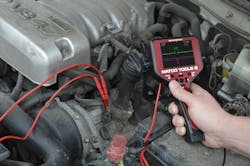This tool goes a step further than scan tools when it comes to “taking the pulse” of a vehicle fault.
You hear it all the time: cars are computers on wheels. What was once largely mechanical has turned unmistakably technical. It makes sense, then that a sophisticated vehicle calls for sophisticated tools. Enter the labscope.
Shop owners may be interested in this product when they want to get to the bottom of an intermittent fault, or when they need examine a system very closely to in order to check for anomalies.
But first-- what is a labscope? What sets it apart from other diagnostic tools?
Raw data versus interpretation
It may help some to better understand the capabilities of a labscope (or oscilloscope) by first clarifying what it is not. For starters, a labscope is not a scan tool. Information gathered with labscopes is raw, rather than an interpretation. In this sense, many technicians find that labscopes help them find the root cause of an issue or malfunction.
“Scan tools are an important part of diagnostics, but scan tools only provide what the electronic control modules interpret they are seeing,” says TJ Bauman, vice president of sales and marketing at Hickok/Waekon, a company that makes diagnostic test equipment. Unlike scan tools which interface, diagnose and sometimes reprogram vehicle control modules, labscopes see actual raw voltages of what is really going on. They have a wider scope and more detailed capacity to measure data.
The vehicle’s EKG
If a scan tool were a blood pressure test, a labscope would be an EKG, a test that checks for problems with the heart’s electrical activity. The tool’s effectiveness lay in its deep memory and high sample rate to capture and compare large amounts of data for extended periods.
“Labscopes allow you to see the ... full electrical signal of a component or circuit. Everything from ignition testing, to vacuum and pressure,” says Mario Vejar. Vejar works in product development at Injectronic. The company Injectronic USA was founded in 1997 and provides solutions for the automotive service industry. The company designs, manufactures and distributes scantools, labscopes, testers and more.
Vejar adds that these tools allows users to view unique characteristics of particular components--something that can be nearly impossible to do with a multimeter.
“A multimeter is a great tool in the shop, but it sometimes falls short,” he says. “The voltmeter shows more of an average or median voltage, rather than live voltage over a set time period. A powerful labscope can [show] voltage as low as millivolts and as fast as micro-seconds.”
If a scan tool can’t get the job done, it may be time to send in a labscope.
“An oscilloscope is essential in focusing fault analysis when the scan tool fails or can’t isolate the issue,” says Phil Service, automotive business development at Pico Technology. “The scope saves time by quickly verifying which components and systems are operating correctly and which are not, avoiding nonessential teardown and unnecessary part replacement.”
With a labscope like the PicoScope, for example, users can undertake simple tests such as battery alternator testing or advanced testing, thanks to high sample rates and buffer analysis.
What to look for
Common key features of labscopes include multiple channels, voltage ranges, time ranges and the ability to use presets.
Multiple channel technology is a common feature of labscopes. Having multiple channels allows technicians to do comparative analysis of various circuits and systems.
Interested techs may also want to know what range of voltage a tool can be set to. The wider the range, the more coverage the labscope will offer. The same is true of time ranges.
Preset features are also common. Vejar of Injectronic USA says, “‘Preset’ is a pre-defined file that has the labscope settings configured for a particular test, such as a secondary ignition system.” Presets may also show what the typical ‘known good signal’ of a system should look like. A number of labscopes allow users to download presets, such as Injectronic’s CJ4R.
Yet another trend in labscopes is the portable waveform viewer. According to Bauman at Hickok Waekon, this is a portable battery-powered scope which doesn’t require a PC or scan tool to function. “Matco Tools’ MDAUTOWAVE2 is a two-channel viewer capable of up to a million samples a second,” says Bauman. “The unit also has an auto-set feature which adjusts the time and voltage scales for the user. This makes the tool easy-to-use and requires no scope experience to view waveforms.”
Bauman says waveform specifications have been incorporated into vehicle repair manuals over the past decade. “With the right accessory, labscopes can provide secondary spark ignition waveforms, saving technicians time when troubleshooting engine performance concerns.”
Pico recently introduced a feature called CAN FD decoding available through free software updates. CAN FD is a flexible data rate communication protocol being introduced by a number of large vehicle manufacturers. Service says such vehicles will inevitably find their way through to the aftermarket sector over the next few years.
Today’s labscopes or oscilloscopes have the capacity to do a great number of specific tests on vehicles. For example, the PicoScope offers 150 guided tests to help connect to vehicle components and analyze data.
Get them started
“An easy test for a distributor to demo would be a secondary ignition test,” says Vejar. “The shop will be able to see an ignition event in real time. This is usually an eye opener for shops that are just getting into scopes.” For more advanced shops, he says showing them the current ramping or a pressure transducer will usually do the trick.
Some scopes offer a “demo mode” which allows technicians to see a sample of a live waveform demonstrates features like time and voltage bases, as well as triggers.
When showing this product, a seller might ask a prospective buyer whether they have repeat repairs and customer returns, or if they ever have to refuse diagnostic work. They may also ask how a tech verifies a fault is fixed before returning the vehicle (PicoScope, for example, prints a ‘before and after’ waveform to show the customer, which can be an added reassurance).
Hickock Waekon specifically designed a unit for distributors to demo MDAUTOWAVE, MDAUTOWAVE2 and AUTOWAVE. Bauman says the demo unit allows distributors to “tote and promote” or let techs try the unit out right on the truck.
Sell support
Distributors might also ask a technician how much engine troubleshooting they do, or the age of the vehicles they predominantly work on. Bauman says any vehicle manufactured in the last decade has a high potential for needing waveform diagnostics.
In addition to the features mentioned about, buyers of labscopes will likely be interested in knowing what accessories are available and what kind of technical support and training is offered. A labscope might come with accessories like secondary ignition probes, pressure transducers, attenuators, current probes and more.
“Some products are very user friendly and require no experience to jump right in. Accessories that are available for the scope, secondary spark ignition for example, add more value for the user,” says Bauman.
He adds, “With any tool investment, meeting the customer’s needs is always key.” When selling or offering information on labscopes, Bauman recommends considering the experience level of the end user using the scope and whether or not they will need training.
Vejar with Injectronics agrees that tech support on this tool is a big deal. “Injectronic USAoffers automotive trained technicians to help with any on-car support call. These guys are not sales guys, but dedicate their time to offering car support.”
Many companies also offer a training library with their labscope that offers information on how to get started and what to look for. The online library at Pico offers access to more than 3,000 waveforms for download.
Call it what you will, the labscope or oscilloscope is a fascinating device that can get to the bottom of a fix quickly, and give customers the reassurance they seek that their issue has been examined, understood and addressed. As labscopes evolve and improve over time, they will continue to be a must-have tool for repair pros.



